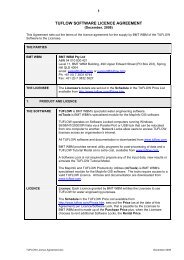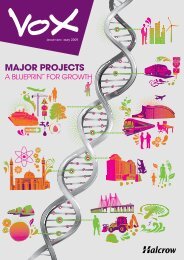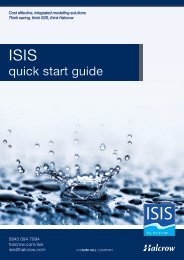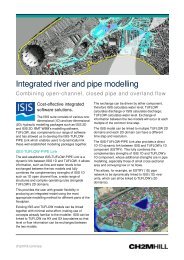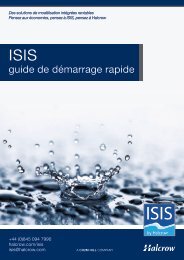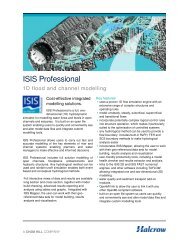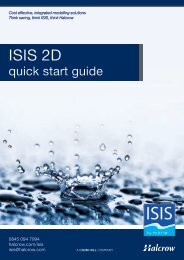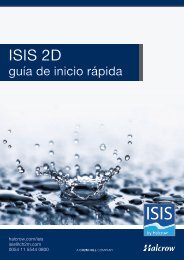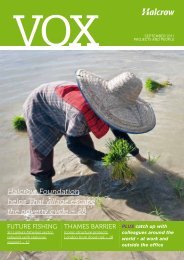December 2008 - Halcrow
December 2008 - Halcrow
December 2008 - Halcrow
You also want an ePaper? Increase the reach of your titles
YUMPU automatically turns print PDFs into web optimized ePapers that Google loves.
Full of (renewable)<br />
energy<br />
ive employees from the renewable<br />
F<br />
energy team presented papers –<br />
based on <strong>Halcrow</strong> projects – to an<br />
international audience of 2,000 delegates at the<br />
Glasgow-hosted tenth World Renewable Energy<br />
Congress (WREC) in July.<br />
WREC’s biannual conferences boast a strong<br />
academic flavour in which to impart the transfer<br />
of renewable energy knowledge. The event<br />
attracts a wide audience of world experts, policy<br />
makers, manufacturers and those interested<br />
in the supply, distribution, consumption and<br />
development of energy sources.<br />
<strong>Halcrow</strong>’s speakers considered the potential of<br />
wave, solar, combined heat and power (CHP) and<br />
fuel cell technology to address the energy crisis.<br />
Donna Munro related <strong>Halcrow</strong>’s experience as<br />
the UK partner in a European Union-funded<br />
programme, which aims to increase the mass<br />
urban uptake of solar photovoltaic technology.<br />
John Simmons based his observations on the<br />
potential energy and carbon savings that can be<br />
achieved through CHP based on a West Midlands<br />
Regional Development Agency project, which<br />
mapped heat demand across the region.<br />
The findings of a Highways Agency project formed<br />
the basis of Inma Andina-Pendas’ thoughtprovoking<br />
presentation. It looked at the potential<br />
savings achieved through the use of fuel cell<br />
technology for roadside power applications.<br />
Wave energy<br />
surges forward<br />
Two <strong>Halcrow</strong> experts were invited to<br />
share their experiences of developing<br />
wave power at the WREC.<br />
Iain Mowat presented a paper on<br />
<strong>Halcrow</strong>’s ongoing study into the<br />
wave energy potential of the Western<br />
Isles of Scotland.<br />
He explored the available energy<br />
resource, as well as the technical,<br />
environmental, economic and social<br />
challenges and benefits inherent in<br />
implementing wave power projects.<br />
Developing an effective wave energy<br />
project was the focus for Peter<br />
Croll’s paper. It covered all the major<br />
stages from concept design and<br />
marine developments through to<br />
planning consent and preparing for<br />
construction.<br />
Tartan transition<br />
Scotland on target for 80 per cent cut<br />
in greenhouse gas emissions by 2050<br />
S<br />
cotland’s determined bid to become one of the world’s first<br />
nations to make the transition to a low carbon economy has seen<br />
it enlist the help of <strong>Halcrow</strong> to realise its green dream.<br />
While Scotland only contributes 0.15 per cent of total global carbon<br />
emissions, it still emits a disproportionate level of greenhouse gases in<br />
relation to its size. This initiative also dovetails into the recently devolved<br />
government’s policy priority of sustainable economic growth.<br />
<strong>Halcrow</strong> was commissioned by the Scottish Government to conduct a<br />
strategic environmental assessment (SEA) of its proposals for the Scottish<br />
Climate Change Bill (SCCB).<br />
Such is the importance of the SCCB that it will effectively sit at the heart of<br />
all Scotland’s future policy and decision making activities.<br />
While Scotland only<br />
contributes 0.15 per cent<br />
of total global carbon<br />
emissions, it still emits a<br />
disproportionate level of<br />
greenhouse gases<br />
In essence, the bill aims to create a long-term framework to ensure that<br />
by 2050, it will have delivered an 80 per cent reduction in greenhouse gas<br />
emissions relative to 1990 levels.<br />
As one of the first SEAs to be conducted on draft policy in the whole of the<br />
UK, <strong>Halcrow</strong>’s Scottish-based environment team applied some innovative<br />
thinking and methodologies in undertaking the assessment. With direction<br />
from Nick Murry, the team assessed the potential environmental impacts<br />
of a range of possible future emission reduction measures across nine<br />
key economic sectors. The team also made recommendations for further<br />
increasing the net environmental benefits of policy proposals. Specialists<br />
from AEA Technology provided support in several specific technical areas.<br />
Consultation on the bill has attracted over 21,000 responses and the team<br />
is now working towards the final phase of the SEA statement – expected to<br />
be submitted to the government with the draft bill by the end of <strong>2008</strong>.<br />
Glasgow-based environmental scientist and SEA project manager John<br />
Fox said: “This has been an extremely challenging project as it was the<br />
first SEA of its type carried out in Scotland, coupled with the wide ranging<br />
implications of climate change and emissions mitigation.”




